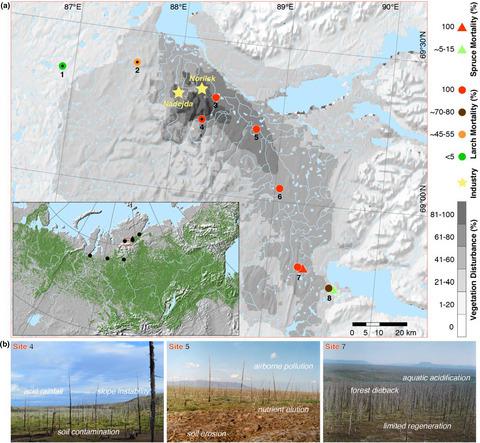当前位置:
X-MOL 学术
›
Ecol. Lett.
›
论文详情
Our official English website, www.x-mol.net, welcomes your
feedback! (Note: you will need to create a separate account there.)
Ecological and conceptual consequences of Arctic pollution.
Ecology Letters ( IF 7.6 ) Pub Date : 2020-09-25 , DOI: 10.1111/ele.13611 Alexander V Kirdyanov 1, 2, 3 , Paul J Krusic 1, 4 , Vladimir V Shishov 2, 3, 5 , Eugene A Vaganov 2, 6 , Alexey I Fertikov 3 , Vladimir S Myglan 7 , Valentin V Barinov 7 , Jo Browse 8 , Jan Esper 9 , Viktor A Ilyin 5 , Anastasia A Knorre 3, 10 , Mikhail A Korets 2 , Vladimir V Kukarskikh 11 , Dmitry A Mashukov 2 , Alexander A Onuchin 2 , Alma Piermattei 1 , Alexander V Pimenov 2 , Anatoly S Prokushkin 2, 3 , Vera A Ryzhkova 2 , Alexander S Shishikin 2 , Kevin T Smith 12 , Anna V Taynik 7 , Martin Wild 13 , Eduardo Zorita 14 , Ulf Büntgen 1, 15, 16, 17
Ecology Letters ( IF 7.6 ) Pub Date : 2020-09-25 , DOI: 10.1111/ele.13611 Alexander V Kirdyanov 1, 2, 3 , Paul J Krusic 1, 4 , Vladimir V Shishov 2, 3, 5 , Eugene A Vaganov 2, 6 , Alexey I Fertikov 3 , Vladimir S Myglan 7 , Valentin V Barinov 7 , Jo Browse 8 , Jan Esper 9 , Viktor A Ilyin 5 , Anastasia A Knorre 3, 10 , Mikhail A Korets 2 , Vladimir V Kukarskikh 11 , Dmitry A Mashukov 2 , Alexander A Onuchin 2 , Alma Piermattei 1 , Alexander V Pimenov 2 , Anatoly S Prokushkin 2, 3 , Vera A Ryzhkova 2 , Alexander S Shishikin 2 , Kevin T Smith 12 , Anna V Taynik 7 , Martin Wild 13 , Eduardo Zorita 14 , Ulf Büntgen 1, 15, 16, 17
Affiliation

|
Although the effect of pollution on forest health and decline received much attention in the 1980s, it has not been considered to explain the ‘Divergence Problem’ in dendroclimatology; a decoupling of tree growth from rising air temperatures since the 1970s. Here we use physical and biogeochemical measurements of hundreds of living and dead conifers to reconstruct the impact of heavy industrialisation around Norilsk in northern Siberia. Moreover, we develop a forward model with surface irradiance forcing to quantify long‐distance effects of anthropogenic emissions on the functioning and productivity of Siberia’s taiga. Downwind from the world’s most polluted Arctic region, tree mortality rates of up to 100% have destroyed 24,000 km2 boreal forest since the 1960s, coincident with dramatic increases in atmospheric sulphur, copper, and nickel concentrations. In addition to regional ecosystem devastation, we demonstrate how ‘Arctic Dimming’ can explain the circumpolar ‘Divergence Problem’, and discuss implications on the terrestrial carbon cycle.
中文翻译:

北极污染的生态和概念后果。
尽管在1980年代,污染对森林健康和森林退化的影响备受关注,但尚未考虑其解释树状气候学中的“发散问题”。自1970年代以来,树木生长与气温上升的脱钩。在这里,我们使用数百个活针叶树和死针叶树的物理和生物地球化学测量结果来重建西伯利亚北部诺里尔斯克附近重工业化的影响。此外,我们开发了一个具有表面辐照度强迫的正向模型,以量化人为排放对西伯利亚针叶林的功能和生产力的远距离影响。从世界上污染最严重的北极地区顺风而下,高达100%的树木死亡率毁坏了24,000 km 2自1960年代以来的北方森林,大气中硫,铜和镍的浓度急剧增加。除了破坏区域生态系统外,我们还演示了“北极变暗”如何解释极极的“发散问题”,并讨论了对地球碳循环的影响。
更新日期:2020-11-12
中文翻译:

北极污染的生态和概念后果。
尽管在1980年代,污染对森林健康和森林退化的影响备受关注,但尚未考虑其解释树状气候学中的“发散问题”。自1970年代以来,树木生长与气温上升的脱钩。在这里,我们使用数百个活针叶树和死针叶树的物理和生物地球化学测量结果来重建西伯利亚北部诺里尔斯克附近重工业化的影响。此外,我们开发了一个具有表面辐照度强迫的正向模型,以量化人为排放对西伯利亚针叶林的功能和生产力的远距离影响。从世界上污染最严重的北极地区顺风而下,高达100%的树木死亡率毁坏了24,000 km 2自1960年代以来的北方森林,大气中硫,铜和镍的浓度急剧增加。除了破坏区域生态系统外,我们还演示了“北极变暗”如何解释极极的“发散问题”,并讨论了对地球碳循环的影响。










































 京公网安备 11010802027423号
京公网安备 11010802027423号